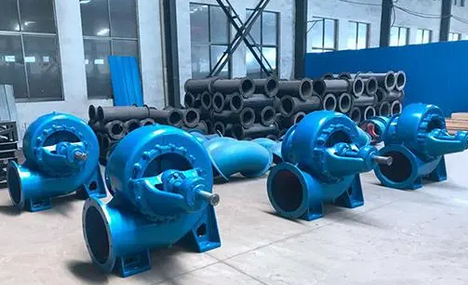What is the difference between an axial flow pump and a mixed flow pump?
Axial flow pumps and mixed flow pumps each have their own unique applications, and the main differences between them are as follows:
I. Working Principle
Axial flow pump:
Working principle: The centrifugal force generated by the rotation of the impeller pushes the liquid along the axial direction. When the pump is full of liquid, the impeller rotates to generate a lifting force on the liquid, transferring energy to the liquid, causing the water to move along the axial direction while rotating with the impeller.
Features: The flow direction of the generated fluid is parallel to the pump shaft, which is suitable for applications with large flow and low head.
Mixed flow pump:
Working principle: Combining the characteristics of axial flow pumps and centrifugal pumps, the design and structure of the impeller realizes that the fluid has both centrifugal and axial flow motion states in the pump. The impeller has both the blades of a centrifugal pump and the blades of an axial flow pump, so that the fluid is sucked in, compressed and accelerated in the pump and then discharged.
Features: The flow direction of the generated fluid is both parallel to the pump shaft and scattered outward, which is suitable for applications with medium flow and medium head.
II. Structure and design
Axial flow pump:
The structure is relatively simple, usually including an inlet pipe, an impeller, a pump body and an outlet pipe.
The design focuses on providing high-velocity liquid flow to meet large flow requirements.
Mixed flow pump:
The structure is relatively complex. In addition to the inlet pipe, impeller and outlet pipe, it also includes accessories such as guide vanes and diffusers.
Guide vanes and diffusers are used to adjust the flow direction and velocity distribution of the liquid to optimize the performance of the pump.

III. Performance parameters
Flow rate (Q):
Axial flow pumps usually have a large flow rate and are suitable for occasions where a large amount of liquid needs to be transported quickly.
The flow rate of mixed flow pumps is small, but it is sufficient to meet the needs of medium flow.
Head (H):
Axial flow pumps usually have a low head and are suitable for low-head applications.
The head of mixed flow pumps is higher than that of axial flow pumps and is suitable for occasions where higher heads are required.
Speed (n):
Axial flow pumps usually have a high speed because they need to quickly push the liquid to flow.
The speed of mixed flow pumps is relatively low, but it is sufficient to meet their performance requirements.
IV. Applications
Axial flow pumps:
Mainly used in applications that require large flows and low heads, such as farmland irrigation, drainage and water treatment.
Mixed flow pump:
Suitable for applications with medium flow and medium head, such as urban water supply, industrial circulation and water conservancy projects.




